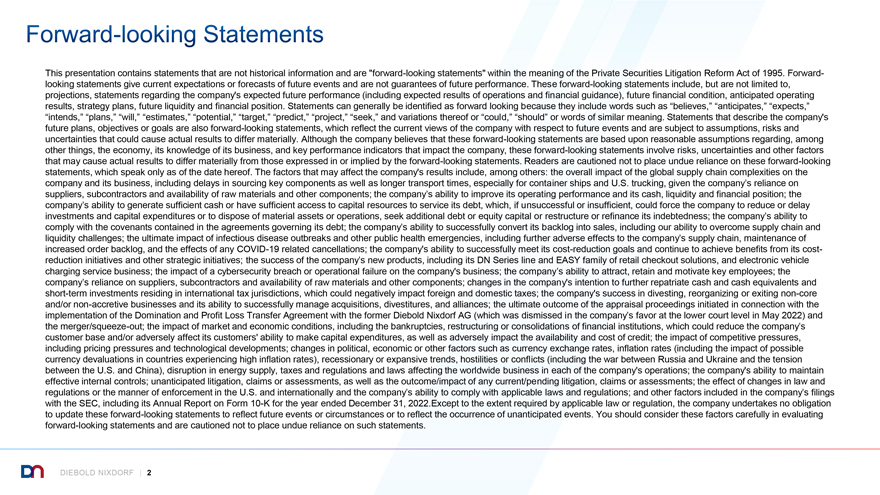
Forward-looking Statements This presentation contains statements that are not historical information and are
“forward-looking statements” within the meaning of the Private Securities Litigation Reform Act of 1995. Forward-looking statements give current expectations or forecasts of future events and are not guarantees of future performance. These
forward-looking statements include, but are not limited to, projections, statements regarding the company’s expected future performance (including expected results of operations and financial guidance), future financial condition, anticipated
operating results, strategy plans, future liquidity and financial position. Statements can generally be identified as forward looking because they include words such as “believes,” “anticipates,” “expects,”
“intends,” “plans,” “will,” “estimates,” “potential,” “target,” “predict,” “project,” “seek,” and variations thereof or “could,” “should”
or words of similar meaning. Statements that describe the company’s future plans, objectives or goals are also forward-looking statements, which reflect the current views of the company with respect to future events and are subject to
assumptions, risks and uncertainties that could cause actual results to differ materially. Although the company believes that these forward-looking statements are based upon reasonable assumptions regarding, among other things, the economy, its
knowledge of its business, and key performance indicators that impact the company, these forward-looking statements involve risks, uncertainties and other factors that may cause actual results to differ materially from those expressed in or implied
by the forward-looking statements. Readers are cautioned not to place undue reliance on these forward-looking statements, which speak only as of the date hereof. The factors that may affect the company’s results include, among others: the
overall impact of the global supply chain complexities on the company and its business, including delays in sourcing key components as well as longer transport times, especially for container ships and U.S. trucking, given the company’s
reliance on suppliers, subcontractors and availability of raw materials and other components; the company’s ability to improve its operating performance and its cash, liquidity and financial position; the company’s ability to generate
sufficient cash or have sufficient access to capital resources to service its debt, which, if unsuccessful or insufficient, could force the company to reduce or delay investments and capital expenditures or to dispose of material assets or
operations, seek additional debt or equity capital or restructure or refinance its indebtedness; the company’s ability to comply with the covenants contained in the agreements governing its debt; the company’s ability to successfully
convert its backlog into sales, including our ability to overcome supply chain and liquidity challenges; the ultimate impact of infectious disease outbreaks and other public health emergencies, including further adverse effects to the company’s
supply chain, maintenance of increased order backlog, and the effects of any COVID-19 related cancellations; the company’s ability to successfully meet its cost-reduction goals and continue to achieve
benefits from its cost-reduction initiatives and other strategic initiatives; the success of the company’s new products, including its DN Series line and EASY family of retail checkout solutions, and electronic vehicle charging service
business; the impact of a cybersecurity breach or operational failure on the company’s business; the company’s ability to attract, retain and motivate key employees; the company’s reliance on suppliers, subcontractors and availability
of raw materials and other components; changes in the company’s intention to further repatriate cash and cash equivalents and short-term investments residing in international tax jurisdictions, which could negatively impact foreign and domestic
taxes; the company’s success in divesting, reorganizing or exiting non-core and/or non-accretive businesses and its ability to successfully manage acquisitions,
divestitures, and alliances; the ultimate outcome of the appraisal proceedings initiated in connection with the implementation of the Domination and Profit Loss Transfer Agreement with the former Diebold Nixdorf AG (which was dismissed in the
company’s favor at the lower court level in May 2022) and the merger/squeeze-out; the impact of market and economic conditions, including the bankruptcies, restructuring or consolidations of financial
institutions, which could reduce the company’s customer base and/or adversely affect its customers’ ability to make capital expenditures, as well as adversely impact the availability and cost of credit; the impact of competitive pressures,
including pricing pressures and technological developments; changes in political, economic or other factors such as currency exchange rates, inflation rates (including the impact of possible currency devaluations in countries experiencing high
inflation rates), recessionary or expansive trends, hostilities or conflicts (including the war between Russia and Ukraine and the tension between the U.S. and China), disruption in energy supply, taxes and regulations and laws affecting the
worldwide business in each of the company’s operations; the company’s ability to maintain effective internal controls; unanticipated litigation, claims or assessments, as well as the outcome/impact of any current/pending litigation, claims
or assessments; the effect of changes in law and regulations or the manner of enforcement in the U.S. and internationally and the company’s ability to comply with applicable laws and regulations; and other factors included in the company’s
filings with the SEC, including its Annual Report on Form 10-K for the year ended December 31, 2022. Except to the extent required by applicable law or regulation, the company undertakes no obligation to
update these forward-looking statements to reflect future events or circumstances or to reflect the occurrence of unanticipated events. You should consider these factors carefully in evaluating forward-looking statements and are cautioned not to
place undue reliance on such statements. DIEBOLD NIXDORF | 2